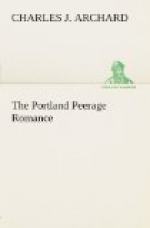Finding that a check was being put upon their operations, the welshing fraternity assumed a virtuous attitude and actually put into operation an old statute passed in the reign of Queen Anne, which enabled any private informer to sue and recover treble the amount of a bet made over and above L10. Six writs were served upon Lord George and six upon his partner, Mr. Bowes, in the year 1843, but the plantiff failed to prove the making of the bets and it is obvious that the statute was unworkable. The attempt to put it into force merely shows the condition of racing at the time and the opposition which men who were honourable in their motives had to meet with in their efforts to guard it against reproach, as far as their sporting instincts allowed them.
In 1844 Lord George had as many as thirty-eight horses running in races, and his estimated expenses in 1845 for sixty horses in training were about L40,000, while, the value of the stakes was about L18,000, so that to make racing pay he had to rely upon the success of his betting transactions.
Disraeli called him the “Lord Paramount of the British Turf,” which well described his ascendency at the time.
Notwithstanding the magnitude of his bets, Lord George was always cool in temperament while other men who, though they might be quite able to stand a loss, were full of nervous excitement when only a small sum was risked.
He kept on terms of affection with his mother and sisters and he could always rely upon the Duchess for help when his racing extravagances had led him too far.
Lord George was over six feet in stature and his figure was handsome and distinguished. His style of dress was according to the best canons of fashion, elegant and fastidious. A long gold chain was looped upon the breast of his waistcoat and with it he wore costly jewels. He had a new satin scarf of cream colour every day, although the cost of each was about a sovereign.
A frock coat and tall beaver hat completed his costume. His race-course attire consisted of a green coat, top boots and buckskin breeches.
When in Nottinghamshire he used to hunt with the Bufford hounds and kept his hunters at Welbeck.
He was a Freemason, though he does not appear to have had time from his devotion to politics and racing to take any high position in the Order. As to some of his personal habits it may be said that he was not a smoker; but he drank four glasses of wine at dinner-time.
The figure of Lord George has been described by his friend Benjamin Disraeli, afterwards Earl of Beaconsfield, in a few striking sentences thus: “Nature had clothed this vehement spirit with a material form which was in perfect harmony with its noble and commanding character. He was tall and remarkable for his presence; his countenance almost a model of manly beauty; the face oval, the complexion clear and mantling; the forehead lofty and white; the nose aquiline and delicately moulded; the upper lip short. But it was in the dark brown eye that flashed with piercing scrutiny that all the character of the man came forth; a brilliant glance, not soft, but ardent, acute, imperious, incapable of deception or of being deceived.”




